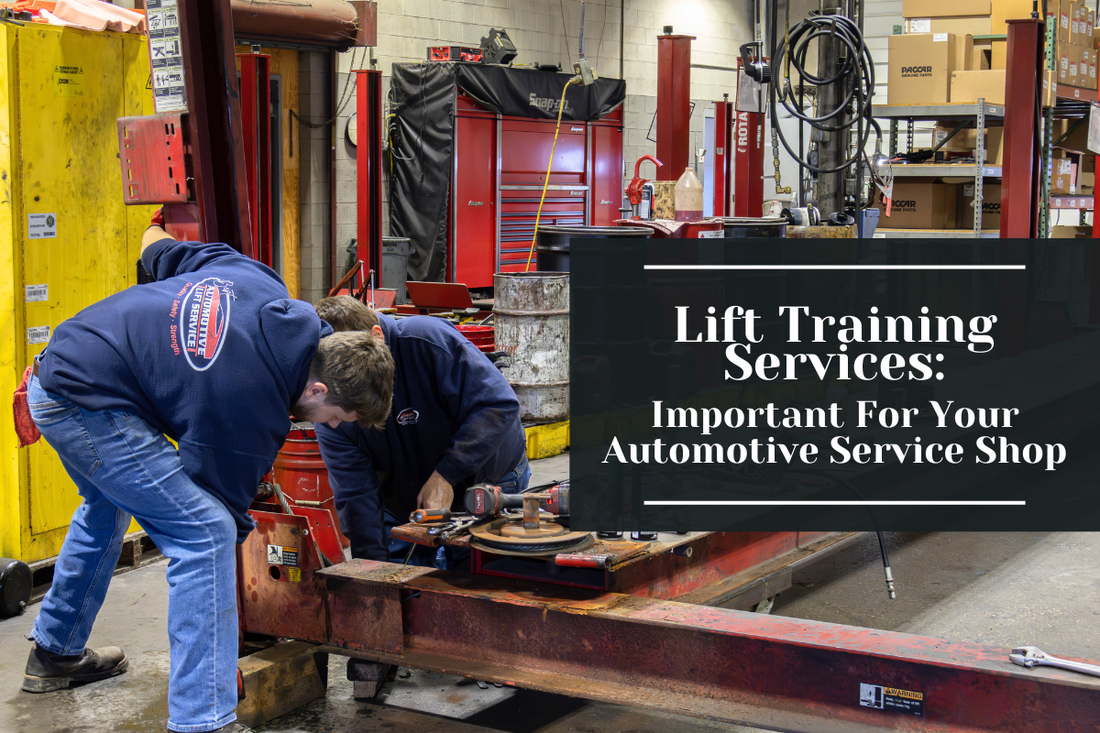
Lift Training Services: Important For Your Automotive Service Shop
Aleigha FuhrmanShare
Automotive service shops rely heavily on vehicle lifts to perform efficient maintenance and repairs. However, improper lift operation can lead to serious injuries, equipment damage, and costly downtime. This is where Lift Training Services come into play. These training programs ensure that your technicians understand how to safely and effectively use lifts, reducing the risk of accidents while increasing overall shop productivity.
If you own or manage an automotive repair shop, investing in lift training for your team is essential. In this blog, we will cover what Lift Training Services are, why they are crucial, and how they can benefit your shop in the long run.
Lift Training Services are professional training programs designed to educate automotive technicians on the safe operation, maintenance, and troubleshooting of vehicle lifts. These programs are typically offered by lift manufacturers, safety organizations, or independent training providers. The training may include a mix of classroom instruction, hands-on practice, and certification exams.
Most Lift Training Services cover the following key areas:
- Types of Automotive Lifts: Understanding different lift types such as two-post lifts, four-post lifts, scissor lifts, and in-ground lifts.
- Safe Operating Procedures: Step-by-step guidance on properly positioning a vehicle, lifting it safely, and lowering it without risk.
- Load Capacity & Vehicle Positioning: Ensuring technicians know how to distribute weight properly to avoid tip-overs.
- Lift Inspection & Maintenance: Learning how to inspect lifts before use and perform routine maintenance to prevent malfunctions.
- Emergency Procedures: Training on how to respond if a lift fails or a vehicle shifts unexpectedly.
By implementing such training, you equip your team with the knowledge and skills needed to operate lifts safely and efficiently.
Prevent Accidents and Injuries
Vehicle lifts can be dangerous when used improperly. If a car is positioned incorrectly or the lift is overloaded, it can lead to catastrophic failures, potentially causing serious injuries or fatalities. According to OSHA (Occupational Safety and Health Administration), improper lift use is a leading cause of workplace injuries in auto shops.
Training your team minimizes these risks by ensuring that every technician knows the proper safety measures, positioning techniques, and weight limits. This reduces the likelihood of workplace accidents and liability issues.
Protect Expensive Equipment and Vehicles
Automotive lifts are a significant investment, often costing thousands of dollars. Misuse or neglect can lead to premature wear and tear, costly repairs, or even complete equipment failure. In addition, improper lift use can result in vehicle damage, leading to expensive repair claims, customer dissatisfaction, and damaged reputation. A trained team will handle lifts correctly, reducing wear on both the equipment and customer vehicles.
Ensure Compliance with Safety Regulations
OSHA and the Automotive Lift Institute (ALI) have strict safety standards for vehicle lift operation. If your shop fails to meet these safety requirements, you could face hefty fines, legal liabilities, or even forced shutdowns.
Proper lift training ensures that your team follows industry-standard safety guidelines, keeping your shop compliant and avoiding legal trouble.
Improve Efficiency and Productivity
A technician who understands how to use a lift correctly can complete repairs faster and with greater accuracy. This results in:
- Quicker turnaround times
- Increased customer satisfaction
- Higher profitability for your shop
When technicians don’t waste time struggling with lift adjustments or dealing with preventable mishaps, they can focus on what matters—delivering quality service.
Lower Insurance Costs: Workplace accidents caused by improper lift use can drive up your shop’s insurance premiums. By implementing proper training and safety protocols, you demonstrate to insurance providers that you are taking the necessary precautions to prevent claims. This can lead to lower insurance rates and significant long-term savings.
How to Implement Lift Training in Your Shop
Now that you understand the importance of training, here are some steps to get started:
Partner with Certified Training Providers: Look for ALI-certified training programs or OSHA-approved courses that cover the latest lift safety standards. Many lift manufacturers also offer in-person or online training sessions.
Conduct Regular Safety Workshops: Training should not be a one-time event. Hold regular safety meetings and refresher courses to keep your team up to date on best practices. Encourage technicians to inspect lifts before each use.
A checklist can include:
Checking for hydraulic leaks
Ensuring lift arms are secure
Verifying weight limits
Looking for signs of wear and tear
Post Safety Guidelines in the Shop: Display clear signage near each lift, outlining step-by-step lifting procedures and emergency protocols. This serves as a constant reminder to follow proper techniques.
Assign a Safety Supervisor: Designate a senior technician to oversee lift safety practices and ensure compliance with training guidelines.
Investing in Lift Training Services is one of the best decisions you can make for your automotive repair shop. Proper lift operation is not just about efficiency, it’s about workplace safety, regulatory compliance, and protecting your employees and assets.
By training your team on how to properly use lifts, you reduce accidents, protect expensive equipment, improve productivity, and lower insurance costs. A well-trained workforce is a safe and efficient workforce, and that translates to better service and higher profitability for your shop.
Don’t wait until an accident happens, take action today and implement lift training for your team!
Call us & chat with one of our Automotive Lift Service experts at (855) 575-1225!
auto lift installer near me, certified lift installation service, car lift installation, lift system for mechanic shop, shop equipment experts, difference between 2 post and 4 post lift, which car lift is best for my shop, scissor lift vs 2 post lift, lift options for auto repair shops, comparing garage lift types, garage lift buying guide, 2 post lift pros and cons, 4 post lift for storage and alignment, car lift installation advice, choosing the right car lift



